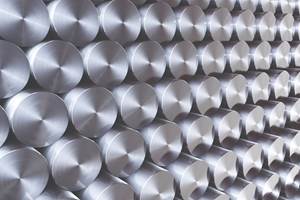PVD Coatings and Tool Steel Selection
Mold users are driving an increased use of physical vapor deposition (PVD) coatings, and this has generated questions and concerns from mold builders as they select materials from which to manufacture their molds. PVD coatings are a family of very thin (approximately 2 to 5 microns) metal layers applied in a vacuum chamber using a plasma process.
Mold users are driving an increased use of physical vapor deposition (PVD) coatings, and this has generated questions and concerns from mold builders as they select materials from which to manufacture their molds.
PVD coatings are a family of very thin (approximately 2 to 5 microns) metal layers applied in a vacuum chamber using a plasma process. To keep this in perspective, there are 25,400 microns in an inch or, in metric, a micron is equal to one millionth of a meter. The PVD process is a line-of-sight process, which means that it can only coat what it can “see.”
When selecting the best option among the variety of available PVD coatings, there are many factors to consider, most importantly wear resistance, lubricity and release. The primary advantage of these coatings is their ability to increase wear resistance over uncoated steel, as most PVD coatings are much harder than the steel substrate. This wear resistance is particularly beneficial for molding high-filled glass resins, which are especially abrasive. PVD coatings can also be used over an existing plating.
Lubricity is the second main benefit of using PVD coatings on molds, as PVD eases the use of slide-type components and similar steels. The third main asset is release of the plastic part from the mold, as PVD helps to reduce part sticking and cycle time. And beyond just evaluating these three factors in general terms, a coating’s micro-hardness (measured in Vickers) should be considered for wear, and its coefficient of friction for release and lubricity. Almost any PVD coating will be harder and “slipperier” than the steel onto which it is being applied.
Once the moldmaker has identified the benefits it is looking to gain, it’s time to examine the various considerations for selecting and using a PVD coating. For example, the PVD coating is applied on top of the substrate, increasing component size by 1-4 microns. This is a factor the moldmaker must now take into consideration for the final build and function of the mold. Also, if the plastic component has fine detail, the variance of the PVD coating to the steel component and how this could affect the final plastic part must be examined.
When it comes to steel selection, the standard grades and heat-treat cycles might need to be changed depending on the selected PVD coating. The moldmaker must ensure that the application temperature of the PVD process is lower than the heat-treatment cycle temperature that is used on the steel. Lead time must be also considered, as the PVD process will be the last step prior to the mold build. This also makes it critical to catch any issues related to the steel selection and the PVD coating as early as possible. Lastly, if welding is required after the PVD process, there are certain steps that are required for removing the coating, and these steps vary by type of coating.
To find the best solution, the customer must find the correct coating for the application and then determine the proper steel to maximize the results. Too often customers allow the steel and heat treatment to determine the coatings that can be considered. The benefits of and considerations for PVD coatings should be discussed during the design of the mold build. Only then can the appropriate coating be applied in the correct areas to improve product quality.
Related Content
VIDEO: Innovative Materials Boost Mold Efficiency
Advancements in metal 3D printing and stainless steel optimize mold building for diverse, high-demand industries.
Read MoreWhat You Should Consider When Purchasing Modified P20 Steel
When buying P20 steels that have been modified, moldmakers must be aware of the variations and key issues that affect delivery, cost and lead times.
Read MoreMoldmakers Deserve a Total Production Solution
Stability, spindle speed and software are essential consideration for your moldmaking machine tool.
Read MoreQualified Tool Steel Enhances Thermal Transfer, Long Tool Life
Next Chapter Manufacturing has successfully qualified HTC-45 tool steel, an optimized version of H13, to support better thermal transfer and faster cycle times for molders and die-casters.
Read MoreRead Next
Tool Steel and Aluminum Staying Strong
A roundtable of mold material suppliers discuss how new offerings result in easier machinability, better weldabilty, increased strength and improved surface hardness.
Read MoreAre You a Moldmaker Considering 3D Printing? Consider the 3D Printing Workshop at NPE2024
Presentations will cover 3D printing for mold tooling, material innovation, product development, bridge production and full-scale, high-volume additive manufacturing.
Read MoreReasons to Use Fiber Lasers for Mold Cleaning
Fiber lasers offer a simplicity, speed, control and portability, minimizing mold cleaning risks.
Read More






.jpg;maxWidth=300;quality=90)














